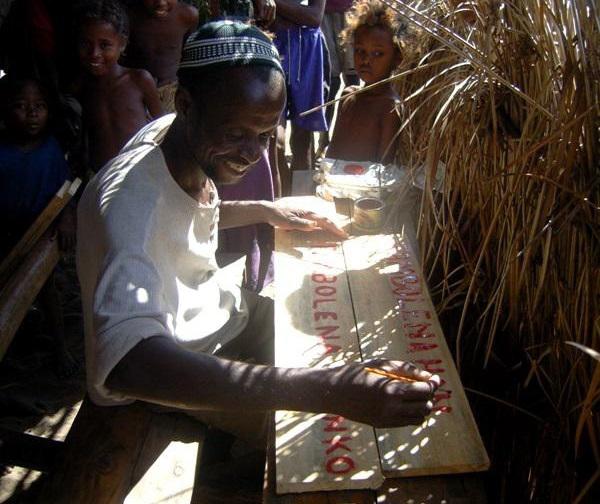Benjamin De Ridder
Other projects
27 Sep 2011
Mangrove Conservation and Restoration through Sustainable Community Development
Our project aims at the participatory and community-based management of the mangroves bordering the coastline of the Bay. Education and sustainability are two key elements of HONKO.
The project is situated in the semi-arid SW region of Madagascar . This area is home to the original nomadic Vezo fishing communities who depend largely on the marine resources. The Bay of Ranobe is situated 27 km north of Tulear in the SW of Madagascar. A rich diversity of ecosystems can be found in the Bay: a 32km long reef bordering the lagoon, sea grass beds intermixed with patch reefs and mangroves in the north and the south. Two rivers (Manombo & Fiherenana) play an important role regulating the Bayʼs ecosystem. These rivers carry run-off from a 7000km2 watershed.

President of Ambondrolava painting a sign to be planted at reforested plots.
The ecosystems in the Bay of Ranobe are under serious threat. Local NGOʼs and dive-operators already recorded a serious decline in healthy reef areas for the last few years. The local Vezo fishermen have to put more and more effort in their time at sea to guarantee a certain level of profit. The fast growing coastal population and the combined increase in need for natural resources form a big threat. The deteriorating mangroves clearly reflect this. Another serious threat forms the looming mineral mining project in the Manombo region.
Mangroves largely contribute to the health of all the ecosystems within the Bay. By making the local people aware of their importance and value, the Bay will stand a better chance to survive increasing stress actors.
The project aims to utilise a multidisciplinary approach. First of all the lack of local knowledge and awareness of the importance of mangrove ecosystems must be addressed. Some local communities already acknowledge the necessity of protecting the remaining forests (by local laws or dina). But the ever increasing need of natural resources urges towards a environmental sound management plan. By informing, training and creating a participatory Mangrove Action Plan, this project seeks to long lasting protection and sustainable utilisation of the remaining mangrove areas. The project seeks to include local knowledge and local people to make it substantial and long lasting. The project also will emphasize the importance of a shift in energy usage by the local communities (ʽgreen charcoalʼ).
The project hopes to be a primer for the region, because several other mangrove ecosystems are considered vulnerable to destruction. By intensively linking and cooperating with other active organisations in the region (Reefdoctor, ADES, WWF, SAGE, ANGAP, CISCO, DREN, DRDR) we seek to create a way of environmental thinking.